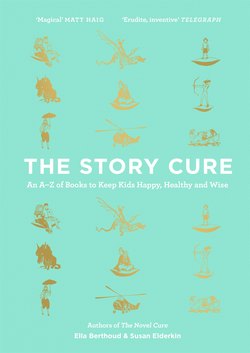Читать книгу The Story Cure - Ella Berthoud - Страница 8
ОглавлениеHOW TO USE THIS BOOK
This book is for grown-ups in the exciting position of choosing books for children – parents, carers, grandparents, friends, teachers, librarians or distant aunts wishing to send a cuddle (or a cautionary tale) from a distance.
It’s arranged like a medical reference book. Look up the ‘ailment’ – be it boredom, bras, or not wanting to go to bed – and you’ll find a ‘cure’ in the form of a story, or two.
Bearing in mind that reading skills and habits develop differently for every child, we’ve organised our ‘cures’ by category rather than age, using the abbreviations PB for Picture Book, ER for Early Reader, CB for Chapter Book and YA for Young Adult fiction. You’ll be able to find books the right level for a child simply by scanning for these initials.
Though each abbreviation correlates roughly to a certain age group (see the table which follows), we recommend that you – and the children you’re reading with – roam freely among the categories. Some kids are reading chapter books by six, and many still love to hear a favourite picture book being read aloud long after they’ve learnt to read by themselves. Challenging subject matter is flagged up within the descriptions. Some ailments – such as being bullied, moving house, and sibling rivalry – span all ages, and therefore we cure with all categories. Others are more age-specific – such as acne, losing your favourite toy, and first kiss – requiring a cure from just one category. Sometimes we mix the categories up: a resonant picture book can be just the ticket for a hard-to-reach adolescent; and of course chapter books – that golden treasure trove – clamour as much to be read aloud as alone, making them great for the shared bedtime read.
In all cases, our cures span well-known and lesser-known stories, classic and contemporary, those written by authors from near and far away, books that are part of a longer series (where necessary, we name the series in brackets), and books that stand alone; but they’re always1 fiction. Sometimes they come as a list – The Ten Best Audiobook Series for Long Car Journeys, for instance, and The Ten Best Bedtime Reads for the Very Little (see here for an Index of Lists). There are ideas for dealing with common reading ailments too, such as being too fidgety to read, or the competition from screens (see here for an Index of Reading Ailments). And because many childhood ailments can be as challenging for the accompanying adult as for the child, we’ve included some Cures for Grown-ups, too (indicated with this symbol). These cures also take the form of children’s books; this is a book about children’s stories, after all, and a good book is a good book,2 whoever it was written for.
| AGE | SYMBOL | DESCRIPTION |
| 6 and under | PICTURE BOOKS. Designed to be shared with a pre-reading child, picture books are a child’s introduction to the very notion of a book, conjuring stories by appealing to all the senses. Hang on to them: many make great beginner readers, and the best ones are multi-layered enough to hold appeal for many years to come. | |
| 5–8 (or beginner readers) | EARLY READERS. Featuring large type, simple words and illustrations, these are books designed with the beginner reader in mind. | |
| 8–12 | CHAPTER BOOKS. These can range from relatively simple to quite sophisticated. Give them to a child to devour in private, or enjoy reading them aloud together, depending on reading ability and whether or not you can bear to miss out on the story. | |
| 12 plus | YOUNG ADULT FICTION. This thriving category in children’s publishing reflects the preoccupations of adolescence. Expect relatively complex and perhaps hard-hitting storylines. Of course, many teens will be ready for adult novels as well; please refer them to our companion volume, The Novel Cure. |
1 Well, almost always.
2 As CS Lewis said, ‘A children’s story that can only be enjoyed by children is not a good children’s story in the slightest.’
